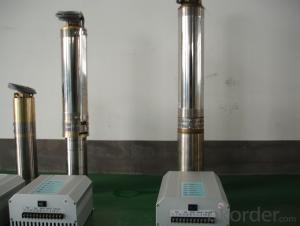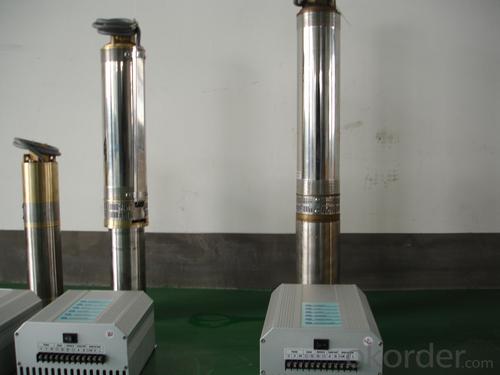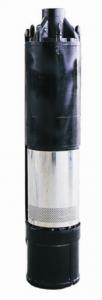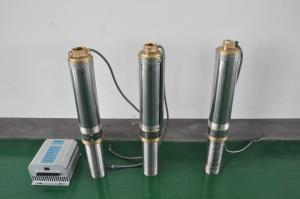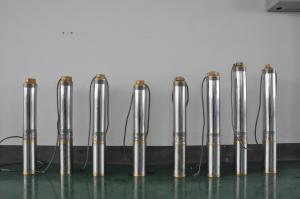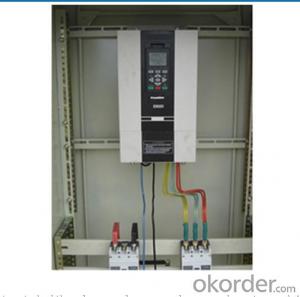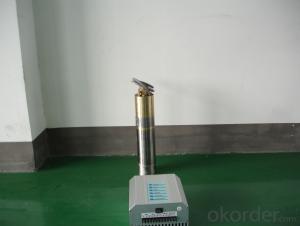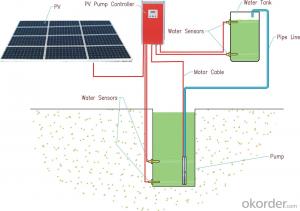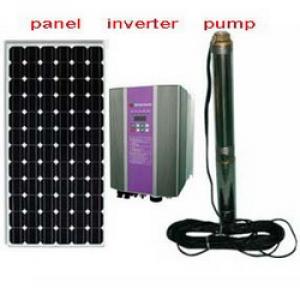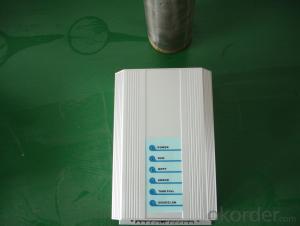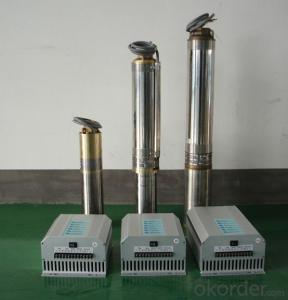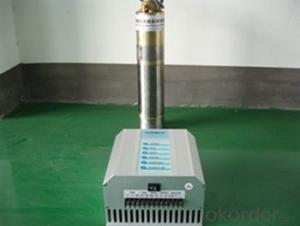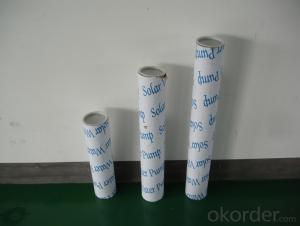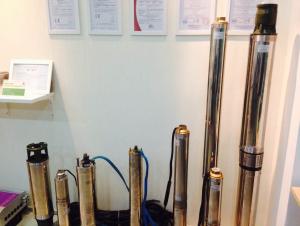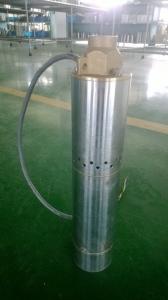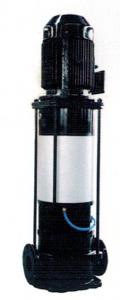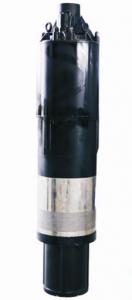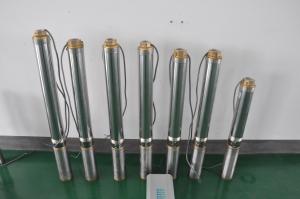DC Solar Water Pump
- Loading Port:
- China Main Port
- Payment Terms:
- TT OR LC
- Min Order Qty:
- -
- Supply Capability:
- -
OKorder Service Pledge
OKorder Financial Service
You Might Also Like
Item Description :
This superb new addition to our solar fountain range comes with a 10w solar panel,and a powerful fountain pump that is capable of producing fountains of up to 2m in height. As well as being easy to set up and use.Instruction manual is supplied for assembly and maintenance.
Solar Fountain Key Features :
Powered by direct sunlight
No high voltage electric mains required
Safe for children
Max. height of fountain: 2M
Max. flow capacity: 800 L/H(176 GAL)
10W Polycrystalline solar panel included
18V DC brushless pump
Solar Pump Features :
Can produce fountains up to : 2M (tube height) 1.4M (fountain height)
Comes with multiple nozzle accessories
Cable Length : 5M
Solar Panel Features :
10W peak power.
Polycrystalline highly efficient solar panel
Comes mounted in aluminium frame
Comes with ground stake and rotating knob so you can angle your panel toward the sun
What You Will Get :
10W solar panel
Solar pump
Ground Sake
Nozzle accessories
Precautions :
DO NOT alter or change the product itself or its components
Operate pump in freshwater only, never above 50 degrees celsius
Keep away from flammable liquids
Do not connect to any other power supply other than the included
- Q: Are there any regulations on the disposal of solar pump components?
- The disposal of solar pump components is regulated by various environmental regulations and guidelines to ensure proper handling and minimize the impact on the environment. In the United States, for example, the Environmental Protection Agency (EPA) oversees the disposal of electronic waste, which includes solar pump components. The EPA has established specific guidelines and regulations to prevent the release of hazardous materials into the environment. In addition to federal regulations, many states and local governments have their own regulations on the disposal of electronic waste, including solar pump components. These regulations require individuals and businesses to recycle or dispose of electronic waste through approved channels, such as licensed recycling facilities or collection events. It is important to note that solar pump components may contain hazardous materials, such as lead, cadmium, or mercury. These materials can be harmful to human health and the environment if not disposed of properly. Therefore, it is crucial to follow the regulations and guidelines set forth by the relevant authorities to ensure the safe and environmentally friendly disposal of these components. To determine the specific regulations applicable to the disposal of solar pump components in a particular area, it is recommended to consult with local environmental agencies, waste management authorities, or recycling facilities. These entities can provide accurate and up-to-date information on the proper disposal methods and any specific regulations that must be followed.
- Q: Can a solar pump be used in areas with high wind speeds?
- Yes, a solar pump can be used in areas with high wind speeds. The operation of a solar pump is not affected by wind speeds as it relies on solar energy to power the pump, not wind energy. However, it is important to ensure that the solar panels are securely installed to withstand high wind speeds and that the overall system is designed to handle the specific environmental conditions of the area.
- Q: Can a solar pump be used for fish farming?
- Yes, a solar pump can be used for fish farming. Solar pumps are a cost-effective and environmentally friendly solution for providing water circulation and aeration in fish ponds. They can help maintain water quality, promote oxygenation, and enhance the overall health and growth of fish in aquaculture systems. Additionally, solar pumps are easy to install and operate, making them a suitable choice for fish farmers in remote areas or off-grid locations.
- Q: Are there any government incentives or subsidies for using solar pumps?
- Solar pumps can benefit from government incentives and subsidies. Governments worldwide understand the importance of promoting renewable energy, such as solar power, and have introduced various programs and incentives to encourage the adoption of solar pumps. Tax credits and rebates are a popular form of incentive provided by many governments. Individuals and businesses that invest in solar pump systems can receive these credits or rebates, significantly reducing the upfront costs of purchasing and installing solar pumps. As a result, solar pumps become more affordable and appealing to consumers. In addition to tax credits and rebates, some governments offer grants or subsidies specifically aimed at promoting the use of solar pumps in certain sectors or regions. These grants help offset the costs of purchasing and installing solar pump systems, making them more accessible to farmers, rural communities, or areas with limited access to electricity. Moreover, certain governments have implemented net metering policies, allowing individuals or businesses with solar pumps to sell excess electricity generated back to the grid. This not only leads to significant savings on electricity bills but can also generate additional income for the system owner. It is important to note that the availability and details of these incentives and subsidies can vary from country to country and even within different regions of the same country. Therefore, it is advisable to consult the local government or relevant authorities for accurate and up-to-date information on the specific incentives and subsidies available for using solar pumps in a particular location.
- Q: Can a solar pump be used for residential purposes?
- Yes, a solar pump can be used for residential purposes. Solar pumps are an environmentally friendly and cost-effective alternative to traditional pumps that run on electricity or fuel. They use energy from the sun to power the pump, eliminating the need for grid electricity or fuel consumption. Solar pumps can be used for various residential purposes such as supplying water for domestic use, irrigation, livestock watering, and swimming pool circulation. They are especially useful in remote or off-grid areas where access to electricity is limited or expensive. Additionally, solar pumps require minimal maintenance, have a long lifespan, and can significantly reduce energy costs for homeowners.
- Q: Can a solar pump be used for desalination of seawater?
- Yes, a solar pump can be used for the desalination of seawater. Solar pumps are commonly used in combination with desalination systems to provide the necessary energy for the process. Solar-powered desalination systems utilize the energy from the sun to power the pump, which in turn drives the seawater through the desalination unit. This process typically involves reverse osmosis or distillation to remove the salt and impurities from the seawater, resulting in fresh drinking water. The use of solar pumps for desalination offers several advantages, such as being environmentally friendly, renewable, and cost-effective in the long run, as they do not require any external power sources. The availability of abundant sunlight in coastal areas makes solar pumps an ideal choice for desalination projects in regions where freshwater scarcity is a pressing issue.
- Q: Can a solar pump be used for water supply in farms or agricultural fields?
- Yes, a solar pump can be used for water supply in farms or agricultural fields. Solar pumps use solar energy to power their operation, eliminating the need for grid electricity or fuel. They are a cost-effective and sustainable solution for areas with abundant sunlight, as they can provide a reliable water supply for irrigation and other agricultural needs.
- Q: How does the programming and control system of a solar pump work?
- Utilizing a variety of components and technologies, the programming and control system of a solar pump ensures efficient and reliable operation. To begin with, the system comprises solar panels that convert sunlight into electrical energy. These panels are typically installed in a sun-drenched location to maximize energy generation. To prevent battery overcharging, the solar panels are connected to a charge controller that regulates voltage and current. The control system also includes batteries that store the generated electrical energy for later use during periods of limited sunlight, such as at night or on cloudy days. These batteries are linked to an inverter, which converts the stored DC power into AC power suitable for driving the pump motor. The programming aspect of the system involves the implementation of timers and sensors to manage the pump's operation. For example, a timer can be set to activate the pump at specific times when ample sunlight is available. This ensures that the pump operates when sufficient solar energy is present. Moreover, sensors can be integrated into the system to monitor water levels, pressure, and other relevant parameters. By providing feedback to the control system, these sensors allow for adjustments to the pump's speed or halting of operation if certain thresholds are exceeded. This prevents over-pumping or system damage. Additionally, the programming and control system may incorporate remote monitoring and control features. This enables users to remotely monitor the pump's performance, receive alerts about any issues, and make adjustments via a smartphone or computer. These features enhance convenience and enable proactive maintenance. In summary, the programming and control system of a solar pump optimizes its operation by combining the power generation capabilities of solar panels, the energy storage capacity of batteries, and intelligent programming. This results in an efficient, sustainable, and reliable water pumping solution that harnesses the sun's power.
- Q: Can a solar pump be used for water supply in commercial buildings or complexes?
- Certainly, water supply in commercial buildings or complexes can be effectively achieved using a solar pump. These pumps offer a sustainable and cost-effective alternative to traditional electric pumps in such settings. By utilizing solar energy to power the pump and extracting water from wells, boreholes, or other sources, they eliminate the need for electricity and decrease operational expenses. Solar pumps possess the capability to meet the water demand of commercial buildings or complexes. They can be utilized for a variety of water-related purposes, such as irrigation, plumbing, and water circulation systems. Advancements in solar technology have made these pumps more efficient, enabling them to deliver water at high pressures and flow rates, making them suitable for even large-scale water supply needs. Moreover, solar pumps are environmentally friendly as they function on renewable energy, resulting in reduced carbon emissions and reduced reliance on fossil fuels. They also require minimal upkeep and have a long lifespan, ultimately leading to lower overall operational costs. In summary, a solar pump is a viable and sustainable choice for water supply in commercial buildings or complexes. Its ability to harness solar energy makes it an ideal option for those who aim to decrease energy consumption and promote environmental sustainability.
- Q: Are there any environmental benefits to using a solar pump?
- Yes, there are several environmental benefits to using a solar pump. Firstly, solar pumps utilize renewable energy from the sun. Unlike traditional pumps that rely on fossil fuels, solar pumps harness the power of the sun to operate. This reduces the dependence on non-renewable energy sources and helps to mitigate greenhouse gas emissions associated with burning fossil fuels. Secondly, solar pumps do not emit any harmful pollutants or greenhouse gases during their operation. This means that they have a significantly lower carbon footprint compared to pumps powered by fossil fuels. By using a solar pump, you are actively contributing to reducing air pollution and combating climate change. Thirdly, solar pumps require minimal maintenance and have a longer lifespan compared to traditional pumps. This reduces the need for frequent replacements and disposal of old pumps, thereby reducing waste generation. Moreover, solar pumps can be used in remote areas where grid electricity is not readily available. By using solar energy, these pumps provide a sustainable and cost-effective solution for water pumping needs, especially in rural communities. This reduces the reliance on diesel generators or other non-renewable energy sources in such areas. Lastly, solar pumps can help to conserve water resources. By using solar energy to power irrigation systems, farmers can efficiently water their crops, minimizing water wastage. This is particularly crucial in areas facing water scarcity or drought conditions, where every drop of water counts. Overall, using a solar pump has numerous environmental benefits, including reduced greenhouse gas emissions, minimized air pollution, lower carbon footprint, reduced waste generation, and efficient use of water resources.
Send your message to us
DC Solar Water Pump
- Loading Port:
- China Main Port
- Payment Terms:
- TT OR LC
- Min Order Qty:
- -
- Supply Capability:
- -
OKorder Service Pledge
OKorder Financial Service
Similar products
Hot products
Hot Searches
Related keywords
